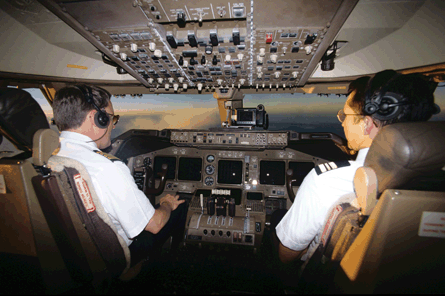 |
|---|
© Rex Features |
Airline pilot performance in non-standard situations is being affected by the way in which line flying has changed over the past 20 years, says Airbus's chief training captain, Jacques Drappier. Now he has gone public with his views.
The most insidious change is the lack of on-the-job manual flying practice pilots are exposed to now compared with 30 years ago, says Drappier, with the result that the manual and thinking skills that once were regularly polished by that experience no longer are.
With the latest generation of aircraft the standard operating procedure for flightcrews is to engage the autopilot/flight director within a minute or so of gear-up and disengage it on short final approach. The 3min or so of handling that pilots get every second flight does not do anything for their flying skills, Drappier contends. Making minor adjustments to the aircraft attitude, with the autothrust still engaged, and applying heading corrections of "about 2° either way" is practice only for take-off, short final, and landing. It is scarcely a preparation for recovering from an unusual attitude at night following an upset, or even handling a diversion entailing a let-down to a circling approach in marginal weather.
Examining the human-factors downsides to the modern way of flying, and what airlines or fractional ownership fleet managers can to do to counter them without busting budgets, is just one issue that will be dealt with at Flight International's Crew Management Conference in London on 30 November and 1 December.
Other crew-management problems to be tackled include preparing for fatigue risk management regulation, and taking advantage of the time-and-money-saving benefits of required navigation performance approaches and departures. The presentations are by world-class people: RNP, for example, is covered by Southwest Airlines' senior director for flight operations Jeff Martin, who has had the task of overseeing his carrier's policy to implement RNP widely. Some airlines strike out to create the future rather than having it imposed on them.
Meanwhile, everybody in the operations world has heard of continuous descent approaches, even if they do not yet use them, but that is not all there is to flying for fuel economy. The conference examines the art and science of flying for fuel economy without having the fuel system or fan blades ice up in the descent.
SOLUTION
The conference offers a solution for lack of handling practice without re-introducing costly real-aircraft circuits with touch-and-goes, or requiring your pilots to do time in an aerobatic Learjet. Delegates will hear how their full-flight simulators can be modified at low cost to a level of motion fidelity that will provide real crosswind landing skills, and get closer to reality in upset-recovery training.
Recent examples of crews that lost monitoring skills because they have become accustomed to the automation doing it for them are seen in the February Turkish Airlines Boeing 737-800 accident on approach to Amsterdam, and the serious incident involving a Thomsonfly 737-300 on approach to Bournemouth airport, UK in September 2007. In both, there was a stealthy automatic systems failure, and the crew did not notice how the speed was decaying until things became serious.
Airbus has also suffered a loss in which human factors of this type may yet turn out to have been a causal component. The Air France A330 that was lost in the cruise over the mid-Atlantic at night on 1 June 2009 went out of control. The aircraft suffered a known disparity in airspeed readings just before it began to descend, but these should have left it controllable. The airspeed disparity had caused the autopilot and autothrottle to trip out. The causes of the accident are not known, but transatlantic operators cannot ignore the human factors that may have been involved.
Several presentations address the need to take pilot training beyond regulatory compliance to retain endangered skills, but they also examine how this can be done without raising costs at a time when survival is challenging safety as the highest priority. Another introduces a selection pilot process that can provide higher predictive accuracy than ever, even promising to show in advance the specific areas of training each individual will require.
The International Air Transport Association is also presenting on how to secure a quality supply of pilots for when the recovery comes. The downturn may cause damage to the training industry that will retard the airlines' ability to restore an adequate pilot supply when they need it again.
Finally, a facilitated workshop will offer delegates a chance to explore in more depth the subject matter from the programme that interests them most, effectively carrying out a peer review of the speakers' claims.
- Find out more about Flight International's Crew Management Conference
Source: Flight International



















